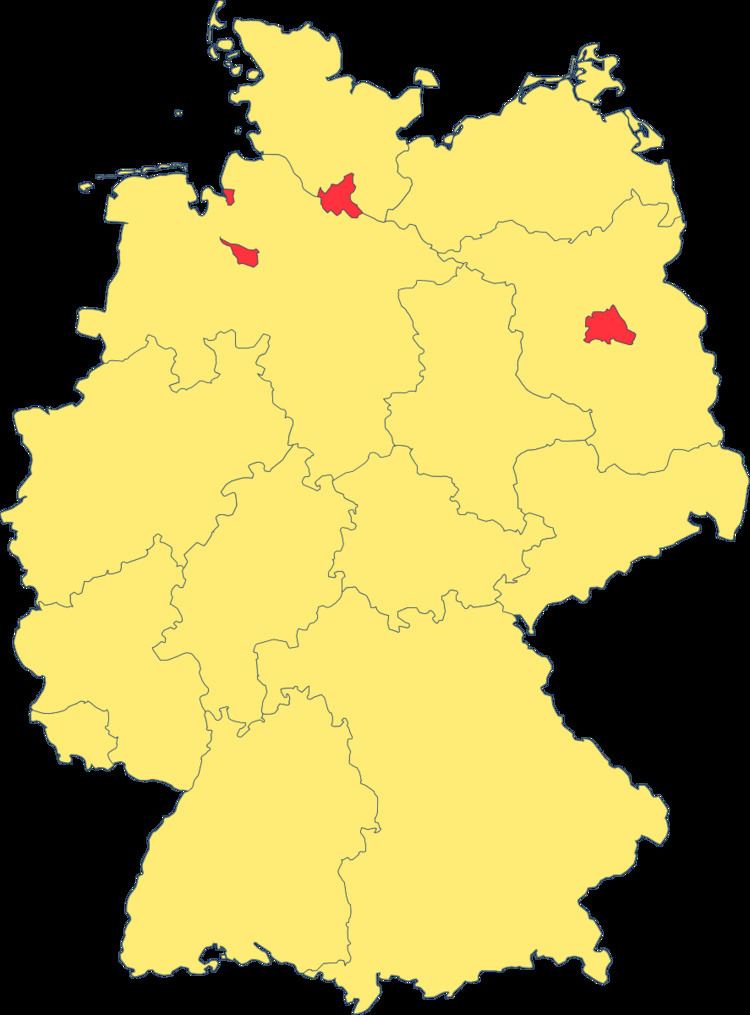The origins of the coats of arms of German federal states covers the historical context for the current arms of the German länder.
After the end of the Third Reich, Germany had lost significant parts of its territory and was divided into four occupation zones. Several former states were split between two or more of these zones. The historical state of Prussia, which spread over more than half the territory of Germany, was officially abolished by the Allies; and several new states were formed from its former lands while other parts were annexed by Poland or the USSR.
Some of these states were direct successors of former states, although the former borders changed; others were new constructions. In some cases parts of former states were declared states; in other cases, parts of different states formed a new state. Only the historic city-states of Hamburg and Bremen survived the end of the Third Reich without significant changes of their territory.
The Federal Republic was joined by the Saarland in 1957 and by five states of the former German Democratic Republic in 1990. Each of these states adopted new arms upon joining the federation, by combining the centuries-old coats of the former states (or ruling houses) from whose territories they were formed.
Coat of arms of Brandenburg
Coat of arms of Brandenburg
Historical arms, including the Province of Brandenburg
Coat of arms of Bremen
Historical arms
Coat of arms of Hamburg
Historical arms
Coat of arms of Hesse
Historical arms
Coat of arms of Lower Saxony
Saxon Steed, principal charge and motif
Coat of arms of the Free State of Brunswick (1918–1946), predecessor state
Coat of arms of the Duchy of Brunswick (1815–1918) (full and lesser), predecessor state
Coat of arms of the Duchy of Brunswick-Lüneburg (1235–1708) predecessor state
Coat of arms of the Electorate of Brunswick-Lüneburg (Hanover), predecessor state
Coat of arms of the Kingdom of Hanover (1814–1866), predecessor state
Coat of arms of the Prussian Province of Hanover (1868–1946), predecessor state
Coat of arms of the Free State of Oldenburg (1918–1946), predecessor state
Coat of arms of Oldenburg (1180–1918), predecessor state
Coat of arms of the Free State of Schaumburg-Lippe (1918–1946), predecessor state
Coat of arms of Schaumburg-Lippe (1643–1918), predecessor state
Coat of arms of Schaumburg (1110–1640), predecessor state
Coat of arms of Mecklenburg-Vorpommern
For history, see Mecklenburg-Schwerin, Mecklenburg-Strelitz and Duchy of Pomerania, predecessor states.
Coat of arms of North Rhine-Westphalia
For history, see also Rhine Province, Province of Westphalia and Principality of Lippe, predecessor states.
Coat of arms of Rhineland-Palatinate
Coat of arms of Rhineland-Palatinate
Wheel of Mainz, principal charge
Coat of arms of the Elector Palatine, principal charge
Coat of arms of the Archbishop of Mainz (historical)
Coat of arms of Saarland
Coat of arms of Saarland
Coat of arms of Nassau-Saarbrücken, predecessor state and one of the quarters of the arms
Coat of arms of the Duchy of Lorraine, predecessor state, predecessor state and one of the quarters of the arms
Coat of arms of the Archbishop of Trier, predecessor state, predecessor state and one of the quarters of the arms
Coat of arms of the Elector Palatine, predecessor state, predecessor state and one of the quarters of the arms
Coat of arms of the Saar under French protectorate (1947–1956)
Coat of arms of the Saar under League of Nations mandate (1920–1935)
Coat of arms of Saxony
Historical arms
Coat of arms of Saxony-Anhalt
Historical arms, including the Prussian province of Saxony
Coat of arms of Anhalt, predecessor Princedom
Coat of arms of Schleswig-Holstein
Coat of arms of the Dukes of Holstein-Gottorp, predecessor dukedom
Coat of arms of Thuringia
Origin of the coats of arms of German federal states Wikipedia (Text) CC BY-SA

